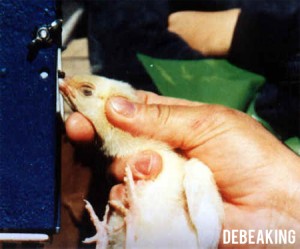Despite the benefits brought by beak trimming, treated birds may experience acute and chronic pain that have been the center of debate for the welfare of laying hens. The beak of bird is covered by rhamphotheca and beneath this hardened layer contains mechanoreceptors, blood vessels, perineural sheaths and nociceptors which can be found throughout the lower and upper mandible. The nociceptors are responsible to send nerve signals to the spinal cord and brain when there is potential tissue damage to the beak. Therefore, behavioral and physiological changes that are caused by the activation of nociceptors after beak trimming are indicators of pain perception.
Pain can be divided into acute and chronic pain. The severity of the pain depends on the age of the bird when the trimming is performed and the amount of beak is removed. Evidence has shown that formation of scar tissue and neuroma are present when beak trimming is performed on older birds. In general, persistent neuroma is a painful condition. On the other hand, there is no neuroma present when beak trimming is performed on young birds because the ability of rapid regrowth of the beak of young birds. As a result, it is recommended that trimming should be done on chicks within 10 days after hatching

